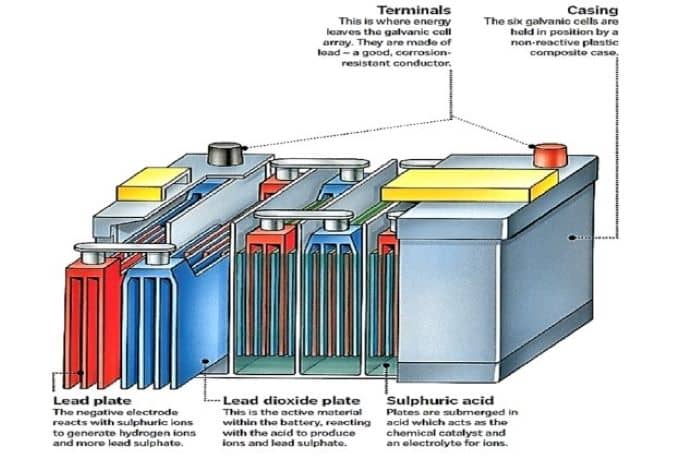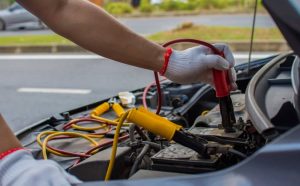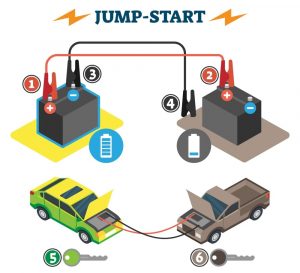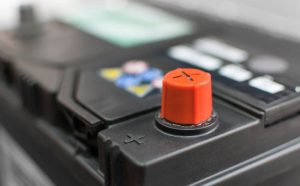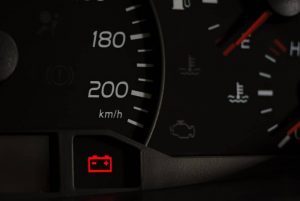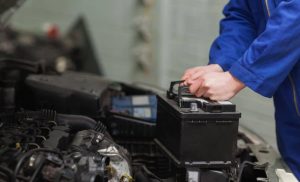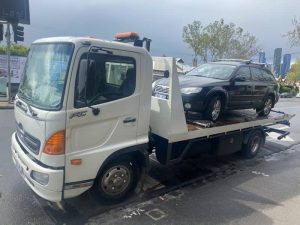A flat car battery is a frustrating event that happens to almost everyone at one point or another. When your battery is doing its job, there is very little need to give it a second thought.
However, the battery can undoubtedly get your attention when it goes bad.
Information for you before you attempt to jump-start your vehicle:
General Anatomy of a Car Battery
Before You Jump-Start the Battery
For your safety, make sure:
- The car is in an area with good ventilation, preferably outdoors. This will protect you from building up fumes in a small, enclosed space.
- Double-check the voltage of both batteries; the voltage should be the same. (Nearly all vehicles have 12-volt batteries).
- Park the cars so the batteries are near each other, but the vehicles should not touch.
- Both cars should have their handbrakes on and either in park or not in gear.
- Turn off anything that could drain the battery, like headlights or the radio.
- Remove battery caps (unless the car has a maintenance-free battery).
- Brush away any powdery residue to ensure a good connection.
What You Need to Jump-Start Your Car
The list of tools for jump-starting a car is short.
- Jumper cables
- Safety gear for eyes
- Gloves
- Flashlight
Jump-Starting Your Car
After the cars are readied, you can begin the jump-starting process.
Connect the Jumper Cables in This Order
- Attach the red clip to the positive terminal on the battery of the car with the flat battery
- Connect the other side of the red clip to the positive terminal of the other car
- Connect the black clip to the negative terminal on the other car
- Take the black clip to the negative terminal of your vehicle but do not connect it to the battery. Attach it to an unpainted metal area on the car near the hood.
- After all clips are in place, start the other car and let it run for several minutes
- While the car is running, check your vehicle for any signs of battery life. Will the radio turn on, or can you see some light from an interior bulb? These are signs that the jump-starting is working. Allow the car to continue to run a bit longer.
- After a few more minutes, try and start your car. If it starts, you have been successful. DO NOT TURN OFF EITHER CAR.
- Begin removing the clips, starting with the black clip that you attached to the metal on your car
- Remove the black clip from the negative terminal on the other car battery
- Unclip the red clip from the positive terminal of the other car
- Detach the red clip from the positive terminal of your car
- Allow your car to run and charge the battery for about 20 minutes before driving away
**Please Note**
Your successful jump-start does not mean your battery is fine. When you return home, turn off your car and then try to restart it. If it starts immediately, you may have some time before you need to buy a new battery. The battery should be checked and charged using a multi-stage charger. This is necessary because, in most cases, your car’s alternator will not be able to charge your battery back up to full strength. At that time, you can ask your auto care professional about batteries and how to keep an eye on yours.
However, if your car will not start again, you should get a new battery to prevent another situation where you are stranded because of a flat battery.
How Do I Identify the Positive and Negative Battery Terminals?
It is critical to the jump-starting process that you get the connections correct. You can tell which battery terminal is positive one of these ways,
- The battery will have “POS” on the positive terminal side
- The battery will have a “+” on the positive terminal side
- The battery’s positive terminal side will be bigger than the negative terminal side.
What Should I Do If My Car Does Not Start After the Jump-Start Attempt?
Not every jump-start works on the first try. Although this is frustrating, you do not need to give up. If your car does not start after the first try jump-starting,
- Allow everything to rest for five minutes and try again
- If your car still does not start, check to be sure each clip is connected correctly and try again
- If your vehicle does not start, allow more time to pass with the other car running before attempting to start the car
- If your auto does not start, you most likely have a battery that is entirely dead. You will need to call a tow truck so you can get your battery replaced
What are the Most Common Types of Batteries?
There are several different types of batteries. Not all varieties are suitable for use in every car.
- Absorbed Glass Mat (AGM) Battery – This is a popular battery that is frequently found in newer cars that have many electronic features. AGM
batteries can hold up in high-drain usages and frequent recharging cycles. Additionally, they work well in the high stress of stop-start ignitions. - Gel Cell Battery– The Gel Cell uses contain an additive made of silica that ‘gelifies’ the electrolyte and also lowers the amount of discharge. This offers increased defence during extreme heat. Additionally, the Gel Cell is used because it provides better protection for heavy-duty vehicles, high-performance cars, or other vehicles that generate heat under stress.
- Valve Regulated Lead Acid (VRLA) – You can purchase the VRLA batteries in both gel cell or AGM types. The VRLA is often chosen because it has a quick recharge capability. What makes this battery different is that it is the battery is dry and sealed to reduce leaks and spills.
- Wet Cell Battery – The wet cell battery is often called the ‘flooded lead-acid’ type. These batteries are usually found in older cars. You can find wet cell batteries in two varieties:
- Maintenance-free – This type has a lifecycle
- Serviceable – This type of wet cell needs you to periodically fill them with distilled water when the electrolyte level falls.
Five Signs Your Car Battery Needs to be Replaced
Even though batteries are often called temperamental, your vehicle frequently shows signs that a battery is knocking on death’s door.
Here are five common indications that your car battery is not long for this world:
- Irregularly Shaped Battery Case – Excessive heat or cold can warp a battery’s shape. Any change from the regular shape of a battery is a cause for concern. Because misshapen batteries can crack and leak battery acid, you should have a car repair expert check your car.
- Corroded Battery Terminals – This issue is easy to spot, even if you are not trained in auto repair. Your battery terminals will have a bluish-green substance caked on them. This gets in the way of a strong connection. In turn, the car cannot adequately charge via the alternator.
- Your Car Ignition Turns Over Very Slowly – Ideally, your vehicle’s engine will start immediately. However, if your car struggles to start, you may be looking at a soon-to-be-dead battery. Because slow starting may also be a symptom of another problem such as the starter or alternator, have a qualified repair person check out the car.
- General Electrical System Problems – Electrical problems can come from several sources. However, dim headlights, issues with your car’s audio system, and unresponsive dashboard lights, windshield wipers, and power controls are all signs of a battery that cannot get the job done.
- The Dashboard Battery Light is Lit – While some drivers are well-versed at ignoring dashboard indicator lights, you should have an expert check out your battery if you see the battery indicator light is lit. It is not worth ignoring this indicator light; have your car looked over by a mechanic.
How to Know if Your Battery is Dead?
It may seem obvious to some but jump-starting your car if the battery is not dead is a bad idea.
Here are some signs that your car’s battery is dead:
- No Response When You Try to Start Your Car
- The Starter Motor Cranks but the Car’s Engine Will Not Turn Over
- Your Car’s Engine Starts and Dies Right Away
- The Headlights and Radio Work but the Engine Will Not Start
- The Battery is Swollen or Misshapen
Electric Cars and Jump-Starting
As electric cars and hybrids continue to rise in popularity, there is a need for accurate information about use and upkeep.
Many people have questions about jump-starting and electric vehicles:
• Can You Jump-start an Electric Car?
Most electric car owners’ manuals say that you should not attempt to jump-start an electric car battery. (If your owner’s manual specifically says do not try and jump-start the car, you should heed the warning. Otherwise, you can void your car warranty.) However, there is one case where it is permissible if you know what you are doing. If you cannot charge your battery by plugging it in, and your car will do nothing (radio, wipers, headlights), then your 12-volt battery is likely dead. While this is an unlikely occurrence, you can charge the battery much like a regular battery.
Another word of caution, if you are attempting to jump-start your electric car, be sure that you are working with the 12-volt battery and not the 200+ volt main battery.
• Can You Jump-start a Gas-powered Car With an Electric Vehicle?
The answer is no. An electric car cannot supply enough power.
• Can You Jump-start a Hybrid Electric Car?
Yes, this is possible because the 12-volt batteries in hybrids are the same as the 12-volt batteries used in gas-powered cars.
Other Ways to Start Your Car if the Battery is Flat
There are a few alternatives to using jumper cables and a good Samaritan to get your car running if the battery is flat.
- Push Starting(also called Bump Starting) – The first thing you must know about push starting a car is the car MUST have a manual transmission. If you have an automatic transmission, bump starting will NOT work.
Steps to bump starting a car:
- Clear a path of at least 90m or more. Steering will be difficult when bump starting.
- Insert the key and turn to the on position.
- Put your transmission in second gear. (First gear has too much torque, and the engine could buck. Third gear needs a high speed to push start).
- Push brake and clutch pedals down.
- As your friends begin to push the car, release the brake.
- Drop the clutch when you reach between 8-10 km/h.
- The engine will buck and sputter as it starts.
- Grip the steering wheel tightly throughout the process
- A Portable Power Pack – Also called a portable jump-starter pack, this is a handy device to keep in your car. It attaches to your car battery just as jumper cables would. The big difference is that you do not need another person to help. All the power you should need is in the pack.
What to Do if Your Battery is Dead
When your battery is dead, and you are effectively stranded alone, it is easy to become greatly upset quickly. However, you will handle the situation better if you control your impulses and try to remain calm.
- Assess Your Situation – Are you seemingly stranded alone at night, or are you nearby areas with many people? The more desolate your location, the safer you are locked inside your car.
- Phone for Roadside Assistance – Tow truck drivers often can get you on your way quickly. Offer the tow truck company detailed information regarding your location if there is no visible address. Make a note of who you contact, the time and date, and other valuable data.
- Phone a Friend – Call a significant other, friend, parent, or another person who you can count on for assistance. Give them the tow truck company’s name and number, your location, and additional helpful information.
- Stay with Your Car – Unless your battery died outside of your favourite cafe, being with your car is safer than trying to walk to someplace in search of help.
- Conserve Your Cell Phone Power – While you will likely be bored, do not use your cell phone power to look at social media.
Potential Hazards when Jump-starting a Car
Generally, the process is not inherently dangerous when the person jump-starting a car knows what to do. However, if you are unsure what you are doing, your safest bet is to wait for knowledgeable assistance.
- Car batteries contain sulfuric acid. The acid can become highly flammable vapours which can leak out of vents. A spark caused by the jumper cables can easily ignite the vapours causing a fire or, in extreme cases, an explosion.
- Jump-starting a car in the rain can be hazardous because water is a fantastic conductor of electricity.
- The electronic systems of newer cars are complex. You could end up with a costly mistake if you make a mistake when jump-starting your car.
Is Jump-Starting Safe?
If your car is newer or a luxury model, the consensus is you should NOT attempt to jump-start it. The main reason behind not jump-starting a modern vehicle is the complex network of electronic components that are at work in your newer car that did not exist years ago.
These electronic parts are technically known as engine control units (ECUs) and constantly monitor the engine. The ECUs maintain efficient operation. This is achieved by using onboard trip computers to inform the driver about fuel efficiency and servicing requirements. Additionally, standard features on modern vehicles such as airbags, cruise control, and Bluetooth operate because of the computer elements. All rely on computers to function.
Many vehicle manufacturers caution against jump-starting a flat battery in their owner’s manual. These parts can easily sustain damage by the power surge that may come along with a jump-start. Your car warranty may become void if you jump-start your car against the maker’s recommendation.
Unless you are sure about what you are doing, calling for roadside assistance is frequently your best bet if your vehicle’s battery dies. If you need help or have questions, feel free to contact Fast Towing Melbourne. Our expert team members can dispatch assistance to you when you are in need. Additionally, they can answer your questions and offer helpful suggestions as well.
** Please Note**
This material is for informational use only. It should not be used to replace a consultation with a car repair expert.

